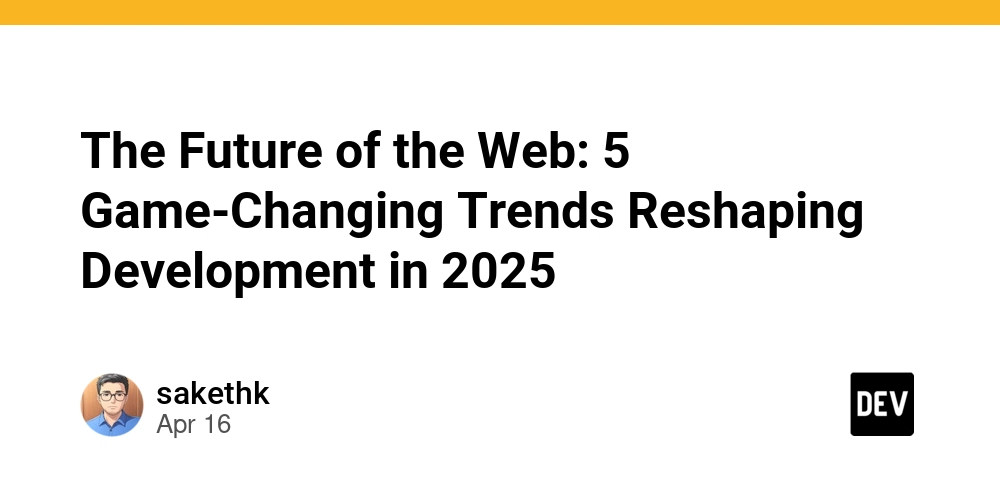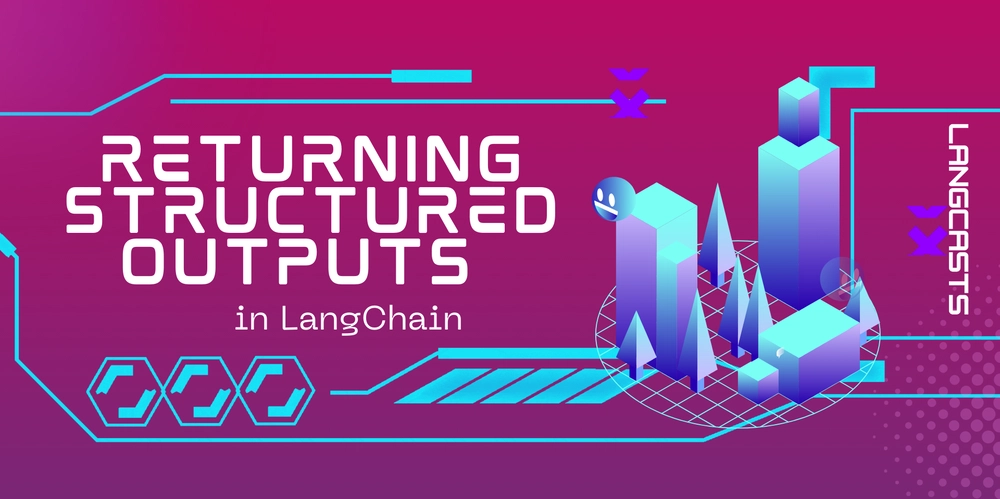The Future of the Web: 5 Game-Changing Trends Reshaping Development in 2025
The Future of the Web: 5 Game-Changing Trends Reshaping Development in 2025 As we approach 2025, the landscape of web development continues to evolve at a breakneck pace. Emerging technologies, changing user expectations, and the ever-increasing demand for more sophisticated web applications are driving innovation across the industry. In this post, we'll explore five key trends that are set to revolutionize web development in the coming years. 1. AI-Driven Development and Code Generation Artificial Intelligence is no longer just a buzzword—it's becoming an integral part of the web development process. By 2025, we can expect AI to play a significant role in various aspects of web development: Automated Code Generation: AI-powered tools will be capable of generating high-quality, bug-free code based on natural language descriptions or rough sketches of desired functionalities. Intelligent Debugging: AI algorithms will analyze code in real-time, identifying potential issues and suggesting optimizations before they become problems. Personalized User Experiences: AI will enable websites to adapt on-the-fly to individual user preferences, creating truly personalized web experiences. For developers, this means a shift in focus from writing every line of code to becoming proficient in leveraging AI tools effectively. The ability to work alongside AI assistants will become a crucial skill in the web development toolkit. 2. WebAssembly: Breaking the Performance Barrier WebAssembly (Wasm) has been gaining traction, and by 2025, it's poised to become a cornerstone of high-performance web applications: Near-Native Speed: Wasm allows developers to run complex applications in the browser at near-native speeds, opening up new possibilities for web-based software. Language Agnostic: With Wasm, developers can write parts of their web applications in languages like C++, Rust, or Go, bringing desktop-level performance to the web. Enhanced Gaming and 3D Graphics: WebAssembly will enable more sophisticated browser-based games and immersive 3D experiences without the need for plugins. As WebAssembly matures, we'll see a blurring of the lines between web and native applications, with more complex software moving to the web platform. 3. Progressive Web Apps (PWAs) 2.0 Progressive Web Apps have already made a significant impact, but by 2025, we'll see a new generation of PWAs with enhanced capabilities: Offline-First Approach: Future PWAs will be designed with offline functionality as a primary feature, not an afterthought. Deep Hardware Integration: Expect PWAs to have greater access to device hardware, enabling features previously reserved for native apps. Cross-Platform Synergy: PWAs will offer seamless experiences across devices, with perfect synchronization and continuity. The evolution of PWAs will challenge the dominance of native mobile apps, providing users with fast, reliable, and engaging experiences directly through their web browsers. 4. Serverless Architecture and Edge Computing The shift towards serverless architecture and edge computing will continue to reshape how web applications are built and deployed: Microservices at the Edge: Developers will leverage edge computing to run microservices closer to the end-user, reducing latency and improving performance. Serverless-First Development: Building applications with a serverless-first mindset will become the norm, simplifying scaling and reducing infrastructure management overhead. Global Distribution by Default: CDNs and edge networks will make it easier than ever to deploy applications globally with minimal configuration. This trend will require developers to adopt new patterns and practices, focusing more on writing efficient, stateless functions rather than managing server infrastructure. 5. JavaScript Evolution and WebGPU JavaScript, the lingua franca of the web, will continue to evolve, and new technologies like WebGPU will push the boundaries of what's possible in the browser: JavaScript Enhancements: Expect new language features that improve performance and developer productivity, possibly including better support for functional programming paradigms. WebGPU Adoption: This new standard will provide unprecedented access to GPU acceleration in the browser, enabling complex visualizations and computations previously impossible on the web. Reactive Frameworks Dominance: Frameworks that embrace reactive programming principles will become increasingly popular, offering better performance and simpler state management. Developers will need to stay abreast of these changes, continuously updating their skills to take advantage of the latest JavaScript features and GPU-accelerated capabilities. Conclusion: Preparing for the Future of Web Development As we look towards 2025, it's clear that web development is entering an exciting new era. The trends we've e

The Future of the Web: 5 Game-Changing Trends Reshaping Development in 2025
As we approach 2025, the landscape of web development continues to evolve at a breakneck pace. Emerging technologies, changing user expectations, and the ever-increasing demand for more sophisticated web applications are driving innovation across the industry. In this post, we'll explore five key trends that are set to revolutionize web development in the coming years.
1. AI-Driven Development and Code Generation
Artificial Intelligence is no longer just a buzzword—it's becoming an integral part of the web development process. By 2025, we can expect AI to play a significant role in various aspects of web development:
- Automated Code Generation: AI-powered tools will be capable of generating high-quality, bug-free code based on natural language descriptions or rough sketches of desired functionalities.
- Intelligent Debugging: AI algorithms will analyze code in real-time, identifying potential issues and suggesting optimizations before they become problems.
- Personalized User Experiences: AI will enable websites to adapt on-the-fly to individual user preferences, creating truly personalized web experiences.
For developers, this means a shift in focus from writing every line of code to becoming proficient in leveraging AI tools effectively. The ability to work alongside AI assistants will become a crucial skill in the web development toolkit.
2. WebAssembly: Breaking the Performance Barrier
WebAssembly (Wasm) has been gaining traction, and by 2025, it's poised to become a cornerstone of high-performance web applications:
- Near-Native Speed: Wasm allows developers to run complex applications in the browser at near-native speeds, opening up new possibilities for web-based software.
- Language Agnostic: With Wasm, developers can write parts of their web applications in languages like C++, Rust, or Go, bringing desktop-level performance to the web.
- Enhanced Gaming and 3D Graphics: WebAssembly will enable more sophisticated browser-based games and immersive 3D experiences without the need for plugins.
As WebAssembly matures, we'll see a blurring of the lines between web and native applications, with more complex software moving to the web platform.
3. Progressive Web Apps (PWAs) 2.0
Progressive Web Apps have already made a significant impact, but by 2025, we'll see a new generation of PWAs with enhanced capabilities:
- Offline-First Approach: Future PWAs will be designed with offline functionality as a primary feature, not an afterthought.
- Deep Hardware Integration: Expect PWAs to have greater access to device hardware, enabling features previously reserved for native apps.
- Cross-Platform Synergy: PWAs will offer seamless experiences across devices, with perfect synchronization and continuity.
The evolution of PWAs will challenge the dominance of native mobile apps, providing users with fast, reliable, and engaging experiences directly through their web browsers.
4. Serverless Architecture and Edge Computing
The shift towards serverless architecture and edge computing will continue to reshape how web applications are built and deployed:
- Microservices at the Edge: Developers will leverage edge computing to run microservices closer to the end-user, reducing latency and improving performance.
- Serverless-First Development: Building applications with a serverless-first mindset will become the norm, simplifying scaling and reducing infrastructure management overhead.
- Global Distribution by Default: CDNs and edge networks will make it easier than ever to deploy applications globally with minimal configuration.
This trend will require developers to adopt new patterns and practices, focusing more on writing efficient, stateless functions rather than managing server infrastructure.
5. JavaScript Evolution and WebGPU
JavaScript, the lingua franca of the web, will continue to evolve, and new technologies like WebGPU will push the boundaries of what's possible in the browser:
- JavaScript Enhancements: Expect new language features that improve performance and developer productivity, possibly including better support for functional programming paradigms.
- WebGPU Adoption: This new standard will provide unprecedented access to GPU acceleration in the browser, enabling complex visualizations and computations previously impossible on the web.
- Reactive Frameworks Dominance: Frameworks that embrace reactive programming principles will become increasingly popular, offering better performance and simpler state management.
Developers will need to stay abreast of these changes, continuously updating their skills to take advantage of the latest JavaScript features and GPU-accelerated capabilities.
Conclusion: Preparing for the Future of Web Development
As we look towards 2025, it's clear that web development is entering an exciting new era. The trends we've explored—AI-driven development, WebAssembly, next-gen PWAs, serverless architectures, and evolving JavaScript ecosystems—will shape the future of the web.
To stay ahead of the curve, developers should:
- Embrace continuous learning, especially in AI and machine learning
- Experiment with WebAssembly and explore its potential for high-performance web apps
- Master PWA development techniques and best practices
- Gain expertise in serverless architectures and edge computing
- Keep up with JavaScript evolution and explore new standards like WebGPU
By focusing on these areas, web developers can position themselves at the forefront of innovation, ready to build the next generation of web applications that will define the digital landscape of 2025 and beyond.
The web of 2025 promises to be faster, more intelligent, and more capable than ever before. Are you ready to be part of this exciting future?




























![[Webinar] AI Is Already Inside Your SaaS Stack — Learn How to Prevent the Next Silent Breach](https://blogger.googleusercontent.com/img/b/R29vZ2xl/AVvXsEiOWn65wd33dg2uO99NrtKbpYLfcepwOLidQDMls0HXKlA91k6HURluRA4WXgJRAZldEe1VReMQZyyYt1PgnoAn5JPpILsWlXIzmrBSs_TBoyPwO7hZrWouBg2-O3mdeoeSGY-l9_bsZB7vbpKjTSvG93zNytjxgTaMPqo9iq9Z5pGa05CJOs9uXpwHFT4/s1600/ai-cyber.jpg?#)














































































































































![[The AI Show Episode 144]: ChatGPT’s New Memory, Shopify CEO’s Leaked “AI First” Memo, Google Cloud Next Releases, o3 and o4-mini Coming Soon & Llama 4’s Rocky Launch](https://www.marketingaiinstitute.com/hubfs/ep%20144%20cover.png)





































































































































































































![Rogue Company Elite tier list of best characters [April 2025]](https://media.pocketgamer.com/artwork/na-33136-1657102075/rogue-company-ios-android-tier-cover.jpg?#)







































































_Andreas_Prott_Alamy.jpg?width=1280&auto=webp&quality=80&disable=upscale#)





































































































![Apple Watch Series 10 Back On Sale for $299! [Lowest Price Ever]](https://www.iclarified.com/images/news/96657/96657/96657-640.jpg)
![EU Postpones Apple App Store Fines Amid Tariff Negotiations [Report]](https://www.iclarified.com/images/news/97068/97068/97068-640.jpg)
![Apple Slips to Fifth in China's Smartphone Market with 9% Decline [Report]](https://www.iclarified.com/images/news/97065/97065/97065-640.jpg)



































































































































